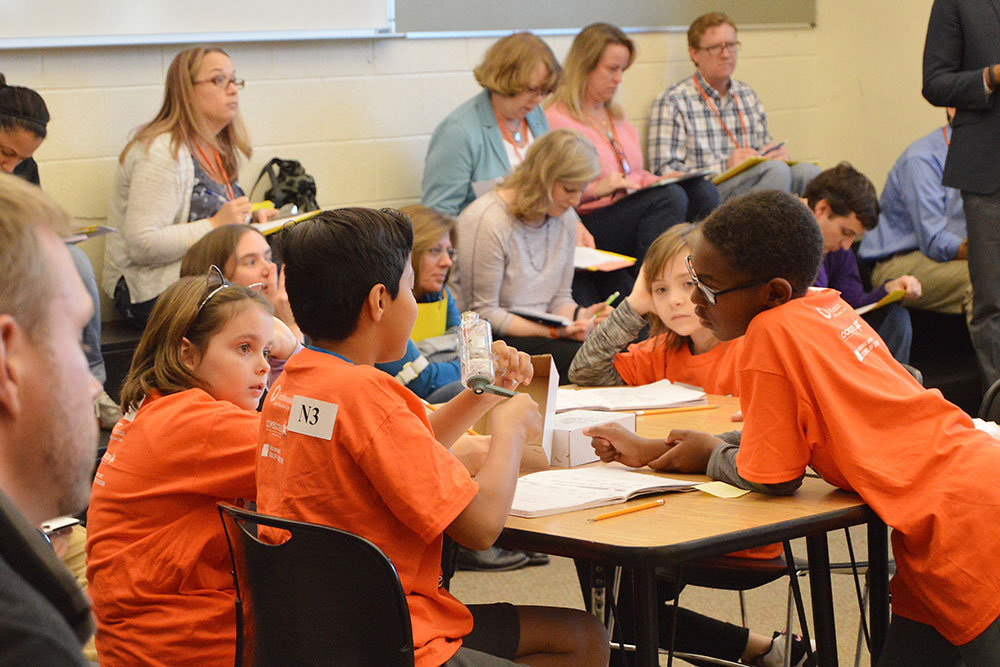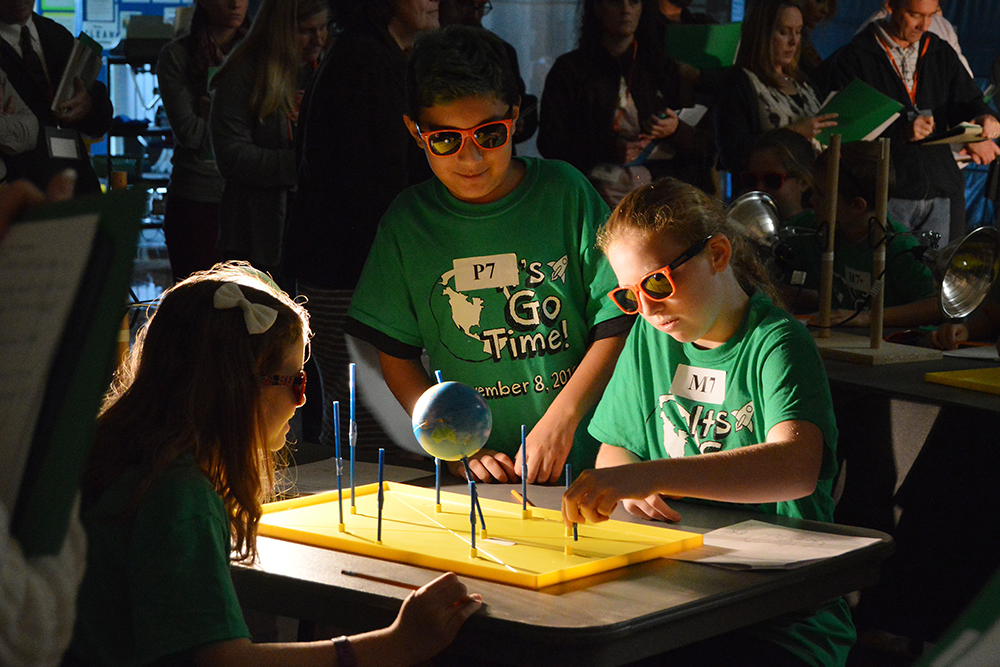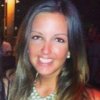Making ambitious practice public: A science-focused lesson study conference summary
The Smithsonian Science Education Center is excited to host guest bloggers Sharon Dotger, Associate Professor of Science Education in the School of Education at Syracuse University, and Jessica Whisher-Hehl, Science Coordinator for OCM BOCES’ Center for Innovative Science Education!
Sharon Dotger is an Associate Professor of Science Education in the School of Education at Syracuse University. She is a lesson study researcher and a practitioner, hosting or participating in more than a dozen open research lessons with teachers in the last decade. Additionally, she has rewritten her on-campus methods course to embody as many features of lesson study as possible and is always on the lookout for more opportunities to make lesson study come alive for her students. Sharon has presented about lesson study in the United States and abroad and supervised lesson study research studies with five doctoral students.
Jessica Whisher-Hehl is the Science Coordinator for OCM BOCES’ Center for Innovative Science Education. Jessica supports K-12 science in 23 school districts by providing professional development and leading an elementary science curriculum materials program. As New York State is in the process of adopting new science standards based on the Framework for K-12 Science Education and the NGSS, Jessica is tasked with leading the region in the implementation of the new standards. A major component of this effort includes transitioning the elementary science curriculum materials program, which serves over 1000 classrooms, to the new units being developed by the Smithsonian Science Education Center. Jessica is currently a doctoral candidate in Science Education in the School of Education at Syracuse University.

A Vignette: A class of fourth-grade students are using hand generators to make observations of change before and after an “interaction”. Their teacher circulates among them, asking clarifying questions about their thinking and encouraging them to add ideas to their science notebook. Surrounding the perimeter of the classroom, 40 teachers and administrators are carefully taking notes about the students and their thinking. At one table, four children are passing the generator among them:
Kim: It has gears in it to make it light.
Adam: When you turn it like this, as I cranked it more, the light starts to show when you twist it. The blue wire...something moves through the blue wire to light it up.
Kim: Can I see it again?
Adam: It starts to fade. There is a battery.
Kim: It's a battery. It’s a generator plus a battery.
Brad: It is starting to heat up. Spin it slowly.
Adam: See the tiny thing at the end? It's like fire coming out.
Kim: Can I see it again? Cool! When you crank it up, the whole machine gets hot, hot. When you stop cranking it, it will stop and cool down.
Molly: The light, ah, it doesn’t do anything.
Kim: If you crank the handle and the light will light up, that is the interaction.
Brad: Spin the handle - it lights up the light bulb and starts heating up.
Kim: Ok, so, after, when you’re spinning, the gears are causing the heat to rise up and go into the canister, it turns into energy and goes through the wires to cause it to heat and light up.
Brad: The light fades quickly, but slow enough so you can see it. No more energy left going into the light bulb because you’re not moving it anymore. If you turn the handle faster, the light will get brighter.
Kim: When you stop cranking the generator, it starts to cool down. If you stop cranking it, the light bulb turns off.
Adam: Yea, it has less power going through it.
These kinds of notes about students’ thinking are recorded throughout the room. When the lesson ends, the students exit to eat lunch. Deb, along with the other teachers who collaborated on the lesson design, take seats at the front of the room. This was the second teaching of this lesson that day - she taught a different group of students earlier in the day with 40 other observers. These other 40 observers enter and a discussion of student thinking begins. Evidence of student thinking is used to evaluate the lesson goals.
Three other lessons like these were happening simultaneously in other spaces throughout the school. A team of second and third grade teachers planned a second grade lesson focused on engineering ways to slow down erosion. A team from multiple grade levels collaborated to plan a lesson about modeling the phases of the moon with sixth graders. The fourth team, with members from multiple grades and buildings, planned a lesson centered on designing a three-step process to clean polluted water for fifth grade students.
Why are those 40 observers in the room? Lesson study: These teams worked together from August to November to engage in lesson study, a professional development and research framework for collaboratively studying student thinking and its relationship to instruction. We relied upon a lesson study process called collaborative lesson research (Takahashi & McDougal, 2016). This process has six essential components: 1) A clear research purpose; 2) kyouzai kenkyuu (ground work for lesson design); 3) A written research proposal; 4) A live research lesson and discussion; 5) Contributions by knowledgeable others; and 6) A process for sharing results.
Our lesson study work drew heavily from the research of Catherine Lewis and her colleagues at Mills College in California (lessonstudyresearch.net), as well as Akihiko Takahashi and his colleagues in Chicago, Illinois (lsalliance.org). Their focus has largely been in elementary mathematics, thus we had to use our developing expertise in science teaching and learning to merge our understanding of their work with our understanding of the goals of the new science standards. Lesson study is highlighted as a promising professional development model to support the teacher learning necessitated by the new science standards (National Academies of Science, Engineering, and Medicine, 2015).
How did these teachers get involved? What did they do to get ready? In February 2016, we invited applications for teams of teachers to participate. We received applications from more teams than we had the capacity to support, a signal that part of our ongoing work needs to construct opportunities for more teachers to learn this way. We were limited by the availability of experienced lesson study advisors and knowledgeable others who had a deep understanding of the new standards and associated instructional practices. Each of the selected teams had one or more participants who had prior experience with lesson study. This was key for helping the teachers succeed: they had to plan ambitious instruction to be taught live, which required deep study along the way and a strong collegial commitment to collaboration. If all team members were novices to lesson study, it would have been much harder for them to make progress quickly enough to be ready for the conference as each team would teach the lesson to 80 observers (each of the over 300 conference participants only saw one live research lesson).
Each of the four lesson study teams were supported by an outside advisor, who facilitated the setup of lesson study norms, supported clear communication, answered questions, and provided general support. The collective work between the advisors and teaching teams began with two full days of work in August. During these meetings, the teams reviewed the lesson study protocol, studied an exemplar research proposal in mathematics and a video of the associated instruction (http://www.lsalliance.org/annual-lesson-study-conference/201...), and studied the Framework for K-12 Science Education: Practices, Crosscutting Concepts, and Core Ideas (NRC, 2012) and the Next Generation Science Standards (NGSS Lead States, 2013) appropriate for their grade level.
As planners, we worked with the SSEC to identify curriculum materials, some of which were newly designed, that aligned with NGSS standards at grades 2, 4, 5, and 6. Teachers worked on studying all of these components, looking for connections to support the design of their lessons. All groups were interested in science notebook writing and making students’ thinking public: their research purposes/themes reflected that interest. Their collaborative study of the Framework, NGSS, science writing research, and curriculum materials - coupled with input from their advisors - guided their kyouzai kenkyuu.
Beginning in September, teams met weekly with their advisors to develop their research lesson proposal and associated unit plans. In order to improve the likelihood of teacher learning from lesson study (see Lewis, Perry, & Murata, 2006 for a description of the range of teacher learning outcomes), research lessons need to be embedded in units of study so teachers can see relationships between students’ prior learning, the learning they exhibit in the research lesson, and the intended learning for the future (Takahashi & McDougal, 2016). For students to meet the new science standards, they need robust, cohesive units that allow their understanding to develop over multiple and progressive learning experiences. This is one reason why lesson study provides a natural fit for professional learning about the new standards, since the deep study of students’ ideas and how they progress is critical to enacting the vision of the standards. The work conducted by the lesson study teams prior to the live research lesson is documented in written research proposals. This comprehensive document articulates unit and lesson plans, rationales for specific aspects of the lesson design, assessment, and board planning. The research plans for the It’s Go Time Conference can be found on the conference webpage.

The conference. On November 8, 2016, over 300 educators representing more than 50 school districts, as well as undergraduate teacher candidates, university faculty, and graduate students, attended the It’s Go Time Conference. The purpose of the conference, co-organized by OCM BOCES and the School of Education at Syracuse University, was to begin our regional progression to the implementation of new state science standards based on the Framework and NGSS. Keynote presentations were given by Dr. Carol O’Donnell, Director of the SSEC, Dr. Carla Zembal-Saul, Kahn Professor of Science Education at Pennsylvania State University and co-director of Elementary Teacher Education, and Tricia Shelton, High School Teacher in the Boone County School District in Florence, Kentucky. Prior to attending a research lesson, the attendees experienced a lesson research introduction lead by the teaching teams. The attendees were divided equally between the four research lessons, where one of the team members taught the lesson live to a group of students who were invited to participate.[1]
The conference participants observed the lessons, gathered careful data about students’ language, writing, materials use, peer-to-peer, and teacher interactions. The goal of the observations was not to evaluate teachers’ practice, but rather to gather data about how students’ thinking emerged or unfolded during the lesson. This is an important point since our education system today emphasizes observing the teacher rather than the students. The idea of focusing on student thinking provides fruitful data from which we can better understand how students’ ideas develop in relation to the lesson, materials, instruction, and peer interactions. The deep learning that occurs by carefully studying student thinking in one lesson often results in practitioner learning that can be applied in other lessons or units. A team member articulated this in a post lesson discussion: “You might think you need to be at the 30,000 foot level to generalize, but what lesson study has taught me is that through deeply focused study, generalizability emerges.” Furthermore, as Ermeling and Graff-Ermeling point out, the transparency provided in live research lessons leads to a collaborative relationship between educators that leads to viewing instructional or learning issues jointly, rather than individually.
The live research observations provided a shared experience, “affording us a shared reference point and opportunity to see our instructional ideas in action rather than merely shared or debated ‘best practices’” (Ermerling & Graff-Ermeling, 2016, p. 44). This aspect of lesson study was revealed during the post-lesson discussions where conference participants met again with the respective lesson study teams. The post-lesson discussion always gives the first word to the teacher who taught the live research lesson and then her team. After that, observers add their data to the conversation. The conversations focus on observations of student thinking in relation to the lesson research theme. In this conversation, colleagues engage in observation-focused discussion that allows for collective reflection on the rationale of the lesson design, the research theme, and associated teaching hypotheses.
The conference concluded with a panel discussion, an opportunity to hear from knowledgeable others. The panel included the keynote speakers, one member from each of the four teaching teams, and the lesson study advisors. The panel discussed if and how the conference goals were met, how representative the lessons were of the NGSS, and answered questions from the audience. During this panel discussion, a high school Earth Science teacher who was part of the 6th grade team discussed how her experience in the lesson research cycle deeply impacted her practices as a secondary science teacher: “I realized through this process that I don’t have to teach my students the content. I am a facilitator that sets up learning experiences that allow students to develop their own understanding. The content learning doesn’t come from me, it comes from the learning activities and students figuring it out themselves.”
We argue that public research lessons, such as those held at the conference, are excellent opportunities for teachers to gain shared experience in evaluating student thinking and developing an understanding of the ambitious teaching and learning required by the new science standards. We know of no other mechanism that is this focused on instruction, led by the goals of teachers, and permits the shared evaluation of student learning in real-time. These shared experiences are critical for continued meaning making - further research will be needed to test this conjecture. But perhaps more importantly, public research lessons help build drastically needed trust between the teachers who conduct the research study and the participants who come into classrooms to observe and gather data. Teaching publicly in the United States remains a rare event. Too often, observations are associated with evaluation of teachers rather than an opportunity to engage in shared inquiry about students’ learning. Lesson study, in addition to being a framework for driving professional learning and research, helps build trust between colleagues. We need collective knowledge building and consistent improvement of practice to achieve the ambitious goals of the NGSS. This work is difficult, but possible if we developed more collaboration grounded in a deep collegial trust.
The ambitious instructional goals embedded in the Framework and NGSS require an equally ambitious professional development response. Lesson study is a professional development model that offers promise. The feedback we received from the conference supports this assertion, as 71% of conference participants indicated that the lesson study focused conference helped them learn about student learning aligned with the new standards and 83% indicated that they would like to attend another conference like It’s Go Time. One participant specifically noted: “This was the most practical and thought-provoking professional conference I have experienced in my 28 years of teaching”. Educators are ready for the deep inquiry into student thinking, standards, curriculum materials, and instruction offered by lesson study. As Carla Zembal-Saul noted in her presentation, the ambitious nature of standards make all of us novices in some way. This conference indicated that we can rise to this challenge - “It’s go time” for our students and ourselves.
References:
- Ermeling, B., & Graff-Ermeling, G. (2016). Teaching better: Igniting and sustaining instructional improvement. Thousand Oaks, CA: Corwin
- Lewis, C., Perry, R., & Murata, A. (2006). How should research contribute to instructional improvement? The case of lesson study. Educational researcher, 35(3), 3-14.
- National Academies of Sciences, Engineering, and Medicine. Science Teachers' Learning: Enhancing Opportunities, Creating Supportive Contexts. Washington, DC: The National Academies Press, 2015. doi:10.17226/21836.
- National Research Council (2012). A Framework for K-12 Science Education: Practices, Crosscutting Concepts, and Core Ideas. Washington, DC: National Academies Press.
- NGSS Lead States (2013). Next Generation Science Standards: For States, By States. Washington, DC: The National Academies Press.
- Takahashi, A., & McDougal, T. (2016). Collaborative lesson research: maximizing the impact of lesson study. ZDM, 1-14. doi:10.1007/s11858-015-0752-x
[1] Students were not hand selected for participation. Any child at the grade level or in a participating teacher's’ classroom was invited. Further, to design a full experience for them, we recruited local community partners to conduct enrichment activities for the students outside the research lesson. All meals and transportation were provided at no cost to the participating children and their families/guardians.
Main header photo by C. O'Donnell. Photos in blog of children courtesy of J. Whisher-Hehl and S. Dotger
